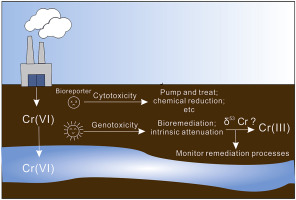Water Research ( IF 11.4 ) Pub Date : 2019-01-21 , DOI: 10.1016/j.watres.2019.01.009
Qiong Zhang , Yizhi Song , Ken Amor , Wei E. Huang , Don Porcelli , Ian Thompson

|
Bioremediation is a sustainable and cost-effective means of contaminant detoxification. Although Cr(VI) is toxic at high concentrations, various microbes can utilise it as an electron accepter in the bioremediation process, and reduce it to the less toxic form Cr(III). During remediation, it is important to monitor the level of toxicity and effectiveness of Cr(VI) reduction in order to optimize the conditions. This study employed a whole-cell bioreporter Acinetobacter baylyi ADPWH-recA to access the degree of toxicity of different species of Cr over a range of initial concentrations. It also investigated whether Cr isotope fractionation factors were impacted by different levels of Cr toxicity (related to its concentration) and Cr(VI) reduction rates by Cr resistant bacteria Pseudomonas fluorescens LB 300. The results show that, of both Cr 2O 72− and CrO 42−, the whole-cell bioreporter was efficient in indicating the level of genotoxicity of Cr(VI) at low concentrations and cytotoxicity at high concentrations via variations of bioluminescence. High concentrations (> 100 mg/L) of Cr(III) could also strongly induce the luminescence in the bioreporter, indicating DNA damage at such abundance. Pseudomonas fluorescens LB 300 was found to be effective in reducing Cr(VI) even when the concentration was high (40 mg/L); however, complete Cr(VI) reduction was only observed at low concentrations (< 5 mg/L), since the toxicity of high concentrations of Cr(VI) impacted the effectiveness of reduction by the bacteria. During reduction, the ratio of remaining Cr(VI) increased from its initial value, and the calculated fractionation factor by bacterial Cr(VI) reduction (ε) was −3.1 ±0.3‰. The fractionation factor was independent of the initial Cr(VI) concentration. Therefore, a single Cr isotope fractionation factor can be effectively applied in indicating the extent of bioremediation processing of Cr(VI) over a wide range of concentrations. This significantly simplified monitoring of Cr(VI) depletion in bioremediation, since variations of ε normally indicate a change in the reduction mechanism and therefore would complicate the elucidation of processes driving the remediation.
中文翻译:

监测Cr毒性和修复过程-结合全细胞生物报告仪和Cr同位素技术
生物修复是污染物排毒的一种可持续且具有成本效益的手段。尽管六价铬在高浓度下是有毒的,但各种微生物仍可以在生物修复过程中将其用作电子受体,并将其还原为毒性较低的六价铬形式。在修复过程中,重要的是监测Cr(VI)还原的毒性水平和有效性,以优化条件。这项研究采用了全细胞生物报告者拜氏不动杆菌ADPWH- rec A,以了解不同种类的Cr在一定的初始浓度下的毒性程度。它还调查了Cr同位素分离因子是否受到不同水平的Cr毒性(与浓度相关)和耐Cr细菌的Cr(VI)还原率的影响。荧光假单胞菌LB300。结果表明,在Cr 2 O 7 2−和CrO 4 2-中,全细胞生物报告剂都能有效地表明低浓度Cr(VI)的遗传毒性水平和高浓度细胞毒性的水平。通过生物发光的变化。高浓度(> 100 mg / L)的Cr(III)也可以强烈诱导生物报告分子中的发光,表明DNA如此丰富时会受到破坏。荧光假单胞菌发现即使浓度很高(40 mg / L),LB 300仍能有效还原Cr(VI)。但是,仅在低浓度(<5 mg / L)下才能观察到完全的Cr(VI)还原,因为高浓度的Cr(VI)的毒性会影响细菌还原的有效性。在还原过程中,残留Cr(VI)的比率从其初始值开始增加,并且通过细菌Cr(VI)还原(ε)计算得出的分馏因子为-3.1±0.3‰。分馏因子与初始Cr(VI)浓度无关。因此,单个Cr同位素分馏因子可以有效地用于指示在宽浓度范围内对Cr(VI)进行生物修复的程度。由于ε的变化通常表明还原机理的改变,因此大大简化了生物修复过程中Cr(VI)消耗的监测,因此将使驱动修复的过程复杂化。

































 京公网安备 11010802027423号
京公网安备 11010802027423号